| Term |
Description |
| acrolithic (2) |
describes a statue with the head and extremities of stone, the trunk being usually made of wood, either gilt or draped (Oxford Dict.) |
| acropolis (2) |
a generic term for a high place or citadel in a city (Pedley, 353) |
| agglomerative (3) |
tending to cluster or heap together (Oxford Dict.) |
| agora (12) |
the market place; the commercial and administrative center of a city (Pedley, 353) |
| agrimia (15) |
plural of agrimi, the Cretain wild goat, a variety of ibex with long horns curving right over to the back; common in Minoan times and frequently depicted with complete realism in Minoan art (Warren, 139) |
| alabaster (12) |
a fine, translucent variety of carbonate or sulphate of lime, especially the pure white variety used for vases (Oxford Dict.) |
| alabastron (14) |
a slim oil container of clay or stone with rounded end, narrow neck, and flaring mouth (Biers, 335; Warren, 139) |
| anta (3) |
a thickened extension at the end of a wall (Biers, 335) |
| antechamber (10) |
a room which leads to the chief room of a building (Oxford Dict.) |
| ard (11) |
a primitive light plough which scratched the surface of the land rather than turning furrows (Oxford Dict.) |
| ashlar masonry (10) |
"construction of blocks of squared stone laid in regular courses (Biers, 335) 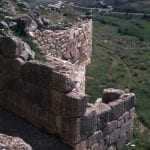 " " |
| askoi (3) |
(sing. askos) a vase in the shape of a sack, skin, or animal (Vermeule, 385) |
| astragal (22) |
knucklebone |
| augur (26) |
soothsay |
| awl (5) |
pointed tool of bone, or of bronze or stone set in a handle, used for boring small holes in hides, wood and other materials (Warren, 140) |
| balustrade (13) |
a row of balusters, surmounted by a rail, forming an ornamented parapet or barrier along the edge of a terrace or balcony (Oxford Dict.) |
| bastion (4) |
"a projecting part of a fortification, consisting of earthwork faced with stone (Oxford Dict.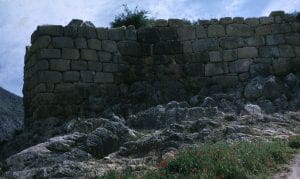 " " |
| battered (7) |
"architectural term meaning a wall deliberately built not vertically but leaning inwards as it rises (Warren, 140)
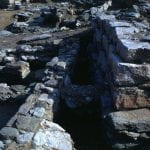
|
| bothros (7) (pl. bothroi) |
a pit in the ground, often used for garbage, sometimes for chthonic offerings (Vermeule, 385) |
| burnish (2) |
"the rubbing or polishing of the surface of a pot with the smooth piece of stone, bone, pottery or wood after it had dried in the sun but before it was fired in the kiln; this technique produced an attractive glossy surface after firing (Warren, 140)

|
| carinated (10) |
"having a profile, common on vessels, where a concave and a convex curve meet to procude a ridge or sharp edge like a keel; Latin carina (Warren, 140)
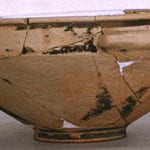
|
| causeway (10) |
"A raised road formed on a mound (Oxford Dict.)  |
| celt (3) |
stone sculptor’s chisel (Oxford Dict.) |
| centrifugal (20) |
tending away from the center |
| centripetal (20) |
tending toward the center |
| chalice (5) |
a drinking cup |
| chamber tomb (13) |
a rectangular chamber cut into the side of a hill and approached by a long entrance passage (dromos) (Biers, 335) |
| chert (2) |
a form of amorphous silica found in several varieties, e.g. flint (Oxford Dict.) |
| chthonic (15) |
an adjective meaning “of the earth” and often referring to the gods of the underworld (Pedley, 353) |
| cist grave (3) |
a shallow rectangular grave cut into the earth or rock, sometimes stone-lined or slab-built (Pedley, 353) |
| citadel (25) |
"literally “little city,” the smaller or inner fortified city (Oxford Dict.)  " " |
| colonnade (12) |
"a range of columns rupporting an entablature (Pedley, 353) 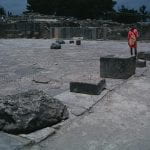 |
|
| conglomerate (19) |
a composite rock consisting of rounded and waterworm fragments of pre-existing rocks cemented together (Oxford Dict.) |
| corbelling (2) |
an arch consisting of architectural members projecting ourward from a wall and bearing the weight of the next course above it. Each course projects slightly beyond the one below. (Biers, 335) |
| cremation (2) |
the reduction of a corpse to ashes as a way of disposing of it (Oxford Dict.) |
| crucible (2) |
a vessel made to endure great heat, used for fusing metals (Oxford Dict.) |
| cut-and-thrust swords (28) |
a new sword type in the Late Mycenaean world, with the hilt-attachment so strengthened that slicing attachs could be made as fearlessly as puncturing attachs (Vermeule, 385) |
| cycladic figurine (2) |
white marble figurine from the central islands of the Aegean sea (Warren, 141) |
| Cyclopean walls (21) |
"Walls built of huge unworked limestone boulders which are roughly fitted together. Between these boulders, smaller hunks of limestone fill the interstices. The exterior faces of the large boulders may be roughly hammer-dressed, but the boulders themselves are never carefully cut blocks. (Rutter, web page) 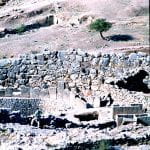 click to enlarge" click to enlarge" |
| dado (10) |
the lower portion of a wall, distinctively decorated (Biers, 335) |
| dagger (10) |
a short stout edged and pointed weapon used for thrusting and stabbing (Oxford Dict.) |
| dais (26) |
a raised platform or table (Oxford Dict.) |
| denticulate (9) |
"having small tooth-like projections (Oxford Dict.) 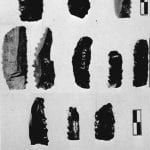 |
| depa amphikypella (4) |
a Homeric term for a two-handled drinking cup misapplied by Schliemann to a peculiar Trojan shape, and used in Linear B for a large jar (Vermeule, 385) |
| dromos (10) |
"the entrance corridor to a tomb of the Mycenaean period (Biers, 335) 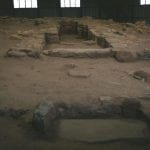 |
| emporium (11) |
a place in which merchandise is collected or traded (Oxford Dict.) |
| ewer (14) |
a pitcher with a wide spout, used to carry water (Oxford Dict.) |
| extramural (2) |
Outside of the walls |
| faience (10) |
quartz grains fused together and covered with a vitreous glaze (Pedley, 354) |
| festoon (9) |
chain or garland of flowers, leaves, suspended in a curved form between two points, or a carved or molded ornament representing a garland (Oxford Dict.) |
| fibula (28) |
a dress pin with a clasp. (Biers, 336) |
| flint (2) |
a kind of hard stone, most commonly of a steely gray color, found in roundish nodules of varying size, usually covered with a white incrustation (Oxford Dict.) |
| fresco (10) |
a wall painting made by rapid application of colors to plaster while still damp (Pedley, 354) |
| frieze (10) |
the architectural course between the architrave (which is supported by the columns/piers) and the cornice (Pedley, 354) |
| frying pan (3) |
a peculiar shape of Cycladic vase whose use is uncertain; possibly made for the kitched but practically never used there; thought by some to be a mirror-case (Vermeule, 386) |
| glyptic (10) |
engraving on a precious stone (Oxford Dict.) |
| griffin (15) |
a mythological beast with the body of a lion, and wings and head of an eagle (Pedley, 354) |
| gypsum (13) |
"a soft stone used in Minoan architecture (Biers, 336) 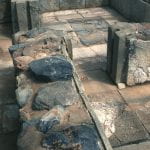 " " |
| half-timbered (9) |
constructed of wooden framework with spaces filled by stone, rubble, or mud brick (Biers, 336) |
| hegemony (18) |
preeminence of one group over others |
| hilt (10) |
the handle of a sword or dagger |
| horns of consecration (15) |
"Evans’ name for clay or stone architectural elements usually used on palace or shrine entablatures, of “divine significance” (Vermeule, 386) 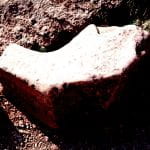 |
| hypogeum (5) |
an underground chamber |
| ingot (10) |
a plate of metal cast in a mold (Pedley, 354) |
| inhumation (2) |
the practice of burying in the ground; interment of a body (Oxford Dict.) |
| insula (7) |
a block of buildings; a square or space divided off (Oxford Dict.) |
| intaglio (15) |
a figure or design incised or engraced; a cutting or engraving in stone or other hard material (Oxford Dict.) |
| intramural (9) |
within the walls |
| ithyphallic (2) |
having an exaggerated erect phallus |
| jamb (10) |
"a base, usually of stone, for a door frame (Warren, 143)
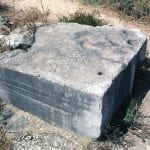 " "
|
| Kamares ware (11) |
Middle Minoan I-II pottery with polychrome decoration in red, orange and white on a black surface; named after its first discovery in the Kamares Cave on the south side of Mount Ida in Crete (Warren, 143) |
| kantharos (8) |
a drinking cup with high swung handles (Biers, 336) |
| katavothros (21) |
sinkhole |
| keel-vaulted (13) |
late Bronze Age rectangular tomb built of stone with a roof which is pitched or gabled like the inverted keel of a boat (Warren, 143) |
| kernos (4) |
(pl. kernoi) ritual vessel with small vases attached in a ring, for libations (Vermeule, 386) |
| krater (14) |
"a large, open, deep bowl, usually of pottery, with handles on the side; used for mixing wine and water (Warren, 143)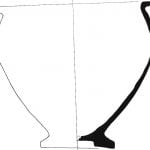 " " |
| kylix (14) |
"a tall, stemmed, shallow drinking cup (Biers, 336)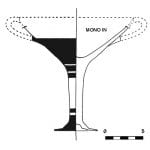 " " |
| labrys (15) |
double headed axe |
| larnax (6) |
terracotta chest; oval types were used by the Minoans as bathtubs and burials; rectangular types with a gabled lid were regularly used for burials; the sides are decorated with abstract patterns, octopuses and scenes of hunting and cult (Warren, 144) |
| libation table (10) |
a table on which liquid offerings, often through rhytons, are poured at religious sites (Warren, 144) |
| lightwell (12) |
a small courtyard or shaft inside a building, uncovered to let in light and air (Pedley, 354) |
| Linear A (10) |
an undeciphered script consisting of simple linear signs apparently derived from older hieroglyphic or pictographic script; used for the Minoan language in the Second Palace period on clay tablets and religious vessels of stone. |
| Linear B (10) |
a script used by the Mycenaeans consisting of simple linear signs apparently derived from older hieroglyphic or pictographic script; deciphered in 1952 as an early form of Greek, expressed in syllables, by Ventris (Warren, 144) |
| lintel (6) |
a horizontal block or beam bridging a door or other opening (Pedley, 355) |
| loomweight (2) |
small terracotta pieces used to hold down the warp threads on a weaving loom |
| lustral basin (10) |
"a small rectangular space, conventionally thought sacred, accessible from above by a short flight of steps (Pedley, 355) 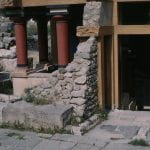 " " |
| macehead (2) |
"polished spherical or solid oval stone with a cylindrical hollow right through for mounting the stone on a stick or shaft (Warren, 144) |
| magazine (12) |
a room in a palaca or house, or a separate building, used for storage and containing large jars to hold cereals and liquids (Warren, 144) |
| mattock (22) |
an agricultural tool used for loosening hard ground (Oxford Dict.) |
| meandroid (2) |
from “meander:” a rectilinear decorative motif, winding backwards and forwards continuously (Pedley, 355) |
| megaron (2) |
"a free-standing, more or less square room entered at one side through one or more anterooms and a two-columned porch. It generally contains a round, fixed hearth. (Biers, 336) 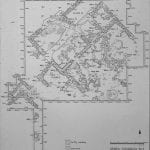 " " |
| microlith (1) |
small stone tool with a sharpened edge used with a haft (Oxford Dict.) |
| millstone (2) |
a circular stone used for grinding grains on a mill (Oxford Dict.) |
| Minyan ware (23) |
"name given to the wheel-made, gray, polished pottery of the Middle Bronze Age on the Greek mainland (Warren, 145) 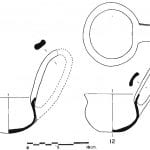 " " |
| apsidal (2) |
Describes a room or building with an apse - that is, a semicircular wall or recess - opposite its main entrance; apsidal long-houses (i.e. megara with a shallow porch, fronted by a pair of columns, leading by means of a central doorway into the building's main room) are, along with rectangular long-houses, the chief forms of residential architecture of the Early and Middle Helladic Greek mainland. |
| Monochrome (2) |
executed in different tints of one color (Oxford Dict.) Sample Image (Lesson 2) |
| mortise (10) |
a cavity into which the end of some other part of a framework or structure if fitted so as to form a joint (Oxford Dict.) Sample Image (Lesson 12) |
| necropolis (10) |
literally “city of the dead,” a cemetery |
| obsidian (2) |
volcanic glass Sample Image (Lesson 8) |
| orthostate course (12) |
the bottom course of a wall, generally two or three times higher than the upper courses (Biers, 337) Sample Image (Lesson 13) |
| ossuary (6) |
a building below ground level, usually an annex to a tomb, for the storage of human bones moved out of the tomb to make room for fresh interments (Warren, 145) |
| ovate (2) |
egg shaped |
| parapet (23) |
a low wall, placed at the edge of a platform, balcony, or roof (Oxford Dict.) |
| peristyle (15) |
a covered colonnade surrounding a building or a court (Biers, 337) Sample Image (Lesson 12) |
| pier |
a freestanding, rectangular mass of masonry supporting the superstructure of a building (Pedley, 355) Sample Image (Lesson 13) |
| pillar (12) |
a detached vertical structure of stone or wood slender or narrow in proportion to its height, used as a vertical support of a superstructure (Oxford Dict.) |
| piriform jar (24) |
vessel which is somewhat like an inverted pear in shape, with a small neck and broad shoulder running down to a smaller base (Warren, 146) |
| pise (2) |
rammed clay and small pebbles forming a wall (Warren, 146) |
| pit grave (16) |
a simple oval or rectangular pit dug in the ground for a grave, its sides sometimes lined and roofed with slabs (Warren, 146) |
| pithos (3) |
"a large clay vessel used to store cereals or liquids (Pedley, 355) 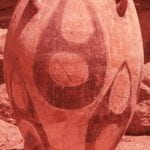 " " |
| pointille (2) |
ornamented with designs engraved or drawn with a sharp-pointed tool or style (Oxford Dict.) |
| pommel (10) |
a rounded protrusion on the handle of a sword or dagger which prevents the hand from slipping (Biers, 337) |
| poros (13) |
"local limestone of a certain pale, spongy quality (Vermeule, 386) 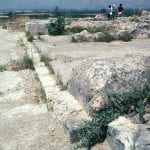 " " |
| portico (12) |
a covered ambulatory consisting of a roof supported by columns placed at regular intervals, usually attached as a porch to a building (Oxford Dict.) |
| propylon (7) |
"(pl. propyla) outer gateway; either an independent entrance building or an element in a wall, usually with a double door and columns supporting a porch on both fronts (Vermeule, 386) 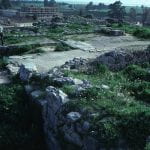  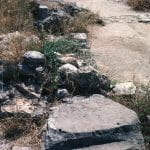 " " |
| pyxis (4) |
a lidded cosmetic or jewelry box; occasionally a knitting basket (Pedley, 355) |
| quern (2) |
a grinding apparatus consisting of two circular stones, the upper of which is turned by hand |
| radiocarbon analysis (1) |
a method of dating that relies on measurement of the rate of decay of carbon 14 in organic remains (Biers, 337) |
| register (14) |
in painting, a horizontal band or frieze decorated with ornament or figures |
| relieving triangle (6) |
"a space, often triangular, left above a lintel in megalithic construction to relieve the weight of the super incumbent masonry (Biers, 337) 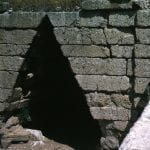 " " |
| repousse (10) |
a metalworking technique in which a design is raised by hammering on the reverse of a metal sheet (Biers, 337) |
| rhyton (10) |
a ritual pouring vessel, sometimes in the shape of an animal head; a drinking horn (Pedley, 356) |
| ring-stemmed goblet |
(Lianokladhi) (23) |
| rubble masonry (3) |
"stone construction in which rubble is used as building material (Biers, 337)  " " |
| sarcophagus (14) |
a coffin, of stone, terracotta, or wood (Pedley, 356) |
| sauceboat (2) |
"modern name for frequently found pottery or metal vessels of the Early Helladic and Early Cycladic cultures. The shape is distinctive and resembles a modern sauce- or gravy-boat with a rising spout on one side. It usually has a ring or pedestal foot and a handle opposite the spout. Its purpose was probably for drinking or for pouring liquids like wine and oil (Warren, 147)
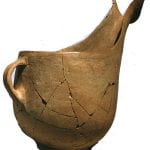
|
| schist (2) |
laminated, easily splitting rock like slate (Vermeule, 387) |
| shaft grave (13) |
"a communal grave at the foot of a shaft dug from the surface (Biers, 337)  " " |
| slag (2) |
refuse matter separated from a metal in the process of smelting (Oxford Dict.) |
| slip (1) |
a coat of clay applied to cover the surface of a pot, of a different constitution from the clay of the pot itself; also used to join together parts of a pot fired separately (Pedley, 356) |
| socle (2) |
"the bottom level of a wall, usually consisting of stone 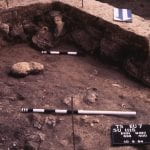 " " |
| spindle whorl (2) |
a weight attached to the end of a spindle to facilitate manipulation of the thread in spinning (Biers, 337) |
| squatter (17) |
one who occupies an uninhabited or abandoned building (Oxford Dict.) |
| steatite (15) |
a variety of talc, commonly of a gray or grayish-green color, with a soapy feel (Oxford Dict.) |
| stipple (24) |
the method of painting or engraving by means of small dots (Oxford Dict.) |
| stirrip jar (14) |
"a rounded vase with a double handle and a narrow spout (Biers, 338)  " " |
| stomion (10) |
"the mouth or door passage of a tholos tomb (Vermeule, 387)  " " |
| sword (10) |
a weapon used for cutting and thrusting, consisting of a handle (hilt) and a blade (Oxford Dict.) |
| syllabary/syllabic script (25) |
writing that employs signs representing syllables (Biers, 338) |
| temenos (15) |
enclosed sacred space |
| tenon (10) |
a projection fashioned on the end or side of a piece of wood or other material, to fit into a corresponding cavity or mortise (Oxford Dict.) |
| terracotta (2) |
"baked clay 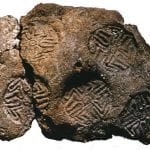 " " |
| thalassocracy (18) |
supremacy on the sea (Biers, 338) |
| thermoluminescence dating (5) |
a method of dating pottery that depends on measurement of the amount of radiation absorbed since a vessel was fired (Biers, 338) |
| tholos tomb (6) |
"a round, corbeled stone tomb, perhaps royal (Biers, 338) 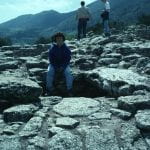 " " |
| threshold (26) |
"the piece of timber or stone which lies below the bottom of a door, and has to be crossed on entering a building (Oxford Dict.)  " " |
| trilithon (6) |
a construction with two upright posts and a horizontal one set on top of them; often the lintel slab set over the doorway of a tholos tomb or over those of Early and Middle Minoan round tombs (Warren, 148) |
| tripod (22) |
a three-legged vessel; a pot or cauldron resting on three legs, often presented as a prize or votive offering (Oxford Dict.) |
| tumulus (3) |
an earth mount over a tomb, whether a tholos or a circular communal precinct (Vermeule, 387) |
| Urfirnis (3) |
"a forerunner of proper glaze paint, descriptive of certain classes of Neolithic and Early Helladic lustrous painted vases (Vermeule, 387)  " " |
| vestibule (6) |
"the enclosed or partially enclosed space in front of the main entrance of a building (Oxford Dict.) 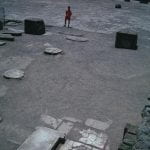 " " |
| votive (1) |
an object dedicated or vowed to a deity (Pedley, 356) |
| whetstone (9) |
a shaped stone used for giving a smooth edge to cutting tools when they have been ground (Oxford Dict.) |
You must be logged in to post a comment.